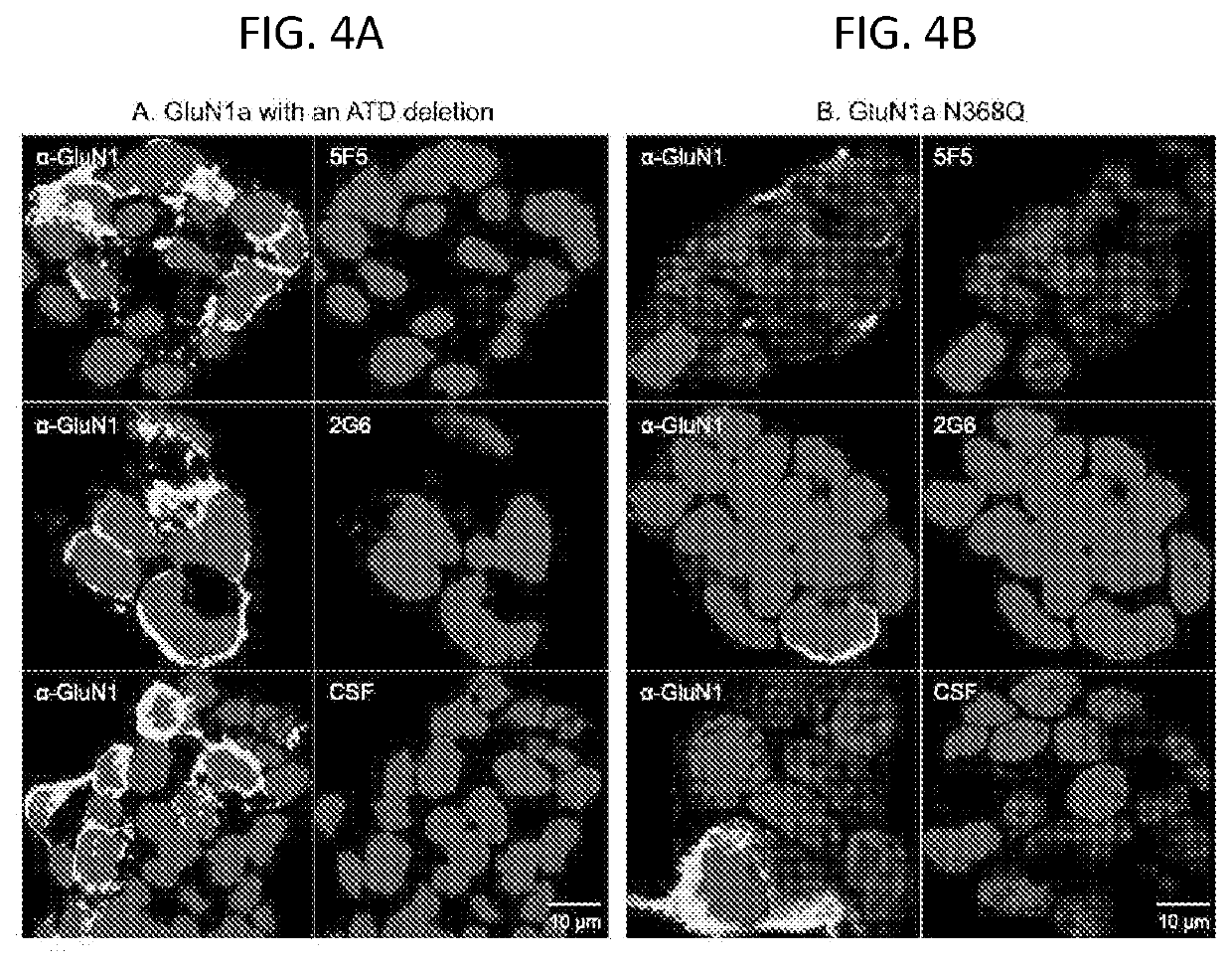Anti-nmda receptor antibodies and methods of use
a technology of anti-nmda receptor and anti-nmda, which is applied in the field of anti-nmda receptor antibodies and methods of use, can solve the problems of difficult diagnosis of autoimmune brain encephalitis (inflammation) associated with psychiatric manifestations, quarter of patients with anti-nmda encephalitis remain severely impaired or die, and recovery often takes years
- Summary
- Abstract
- Description
- Claims
- Application Information
AI Technical Summary
Benefits of technology
Problems solved by technology
Method used
Image
Examples
example 1
and Methods
[0137]A. Cell Culture, Hybridoma Generation and Antibody Purification
[0138]Peripheral blood was obtained from an 18 year-old female who presented to the Children's Hospital of Philadelphia with emotional lability, paranoia, and temporal lobe seizures, with anti-GluN1 IgG detectable in her CSF. Peripheral blood mononuclear cells (PBMCs) were processed and cryopreserved as previously described.10 We performed a cell fusion following standard methods.10
[0139]Briefly, PBMCs expressing the CD27 antigen were isolated with anti-CD27 magnetic beads (Miltenyi Biotec, Auburn, Calif.) and cultured for 8 days in the presence of human UltraCD40L (Multimeric Biotherapeutics, San Diego, Calif.) in advanced RPMI supplemented with 10% fetal bovine serum (FBS), cytokines and other growth factors. On day 8, cultured cells were electrofused to the B5-6T cell line and selected with HAT. Hybridoma supernatants were screened for secretion of IgGs that bind GluN1 by whole cell ELISA (with GluN1...
example 2
of ANRE Patient-Derived Monoclonal Antibodies that are Immunoreactive with Glun1
[0160]We obtained peripheral mononuclear cells from an 18 year-old female who presented with emotional lability, paranoia, and temporal lobe seizures, without an ovarian teratoma, and was found to have anti-NMDAR IgG antibodies in her CSF. We used standard hybridoma methods to obtain two IgG mAbs reactive with the NMDAR expressing 293T cells.7,14 Following purification, we tested 5F5 and 2G6 for binding to N1a / N2b-transfected HEK293T by ELISA, confirming that binding depended on the expression of N1a / N2b (FIG. 1). We further assessed 5F5 and 2G6 binding to N1a / N2b-transfected HEK293T cells by immunofluorescence microscopy, in comparison to ANRE patient CSF, a murine anti-GluN1 mAb, and a control human IgG (8E1) (FIG. 2). 5F5 and 2G6 both showed diffuse, bright, punctate staining in the N1a / N2b-transfected cells only, whereas 8E1 did not stain. The ANRE patient CSF stained the cells in a similar, but more...
example 3
f the 5F5 and 2G6 Mabs to Primary Hippocampal Neurons and Murine Brain
[0167]We next explored interaction of the mAbs with native NMDAR on primary tissues and in vivo. We tested binding of the 5F5 and 2G6 mAbs to cultured rat hippocampal neurons. Commercially obtained hippocampal neurons were cultured for 14 days and confirmed to express MAP2 and GluN1 (data not shown). We fixed the neurons and stained them with 5F5, 2G6, 8E1, or ANRE patient CSF (FIG. 8A). The CSF and the 5F5 and 2G6 mAbs bound to the neurons, whereas 8E1 did not. Coimmunostaining of the neurons indicated substantial overlap between the signals from the 5F5 and 2G6 mAbs and the murine anti-GluN1 mAb (FIG. 8B).
[0168]We next assessed the sites of 5F5 binding on murine primary hippocampal neurons that had not undergone fixation. Double-labelling images showed overlapping patterns with a rabbit GluN1 antibody, though to a lesser degree than IgG from ANRE patient CSF. In contrast to patient CSF, 5F5 immunoreactivity did ...
PUM
| Property | Measurement | Unit |
|---|---|---|
| Fraction | aaaaa | aaaaa |
| Fraction | aaaaa | aaaaa |
| Light | aaaaa | aaaaa |
Abstract
Description
Claims
Application Information
 Login to View More
Login to View More - R&D
- Intellectual Property
- Life Sciences
- Materials
- Tech Scout
- Unparalleled Data Quality
- Higher Quality Content
- 60% Fewer Hallucinations
Browse by: Latest US Patents, China's latest patents, Technical Efficacy Thesaurus, Application Domain, Technology Topic, Popular Technical Reports.
© 2025 PatSnap. All rights reserved.Legal|Privacy policy|Modern Slavery Act Transparency Statement|Sitemap|About US| Contact US: help@patsnap.com



